Closed Loop AIO Liquid Coolers: 14-way Mega Roundup Review
by E. Fylladitakis on February 12, 2014 7:00 AM ESTTesting Results, Maximum Fan Speed (12V)
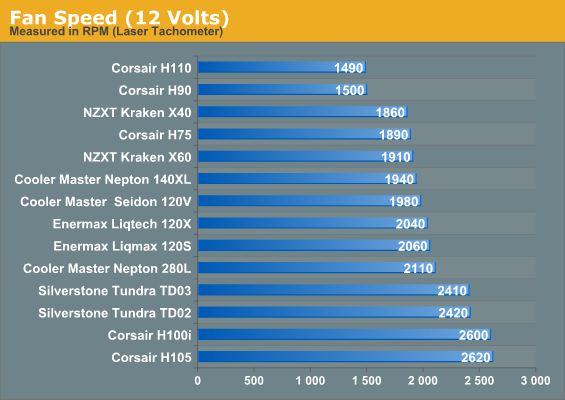
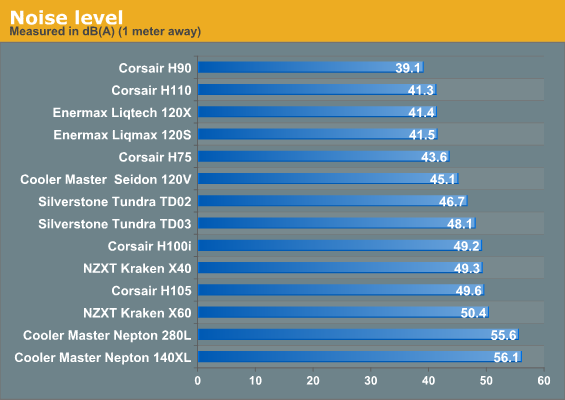
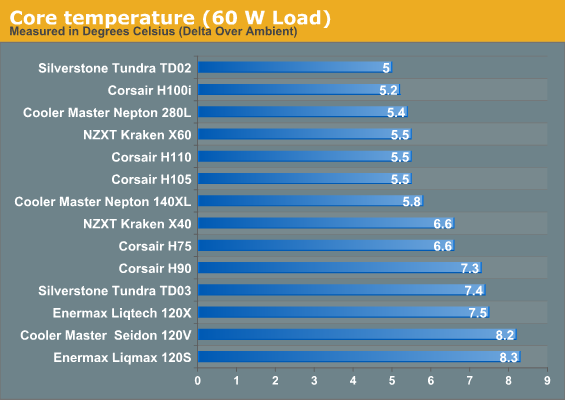
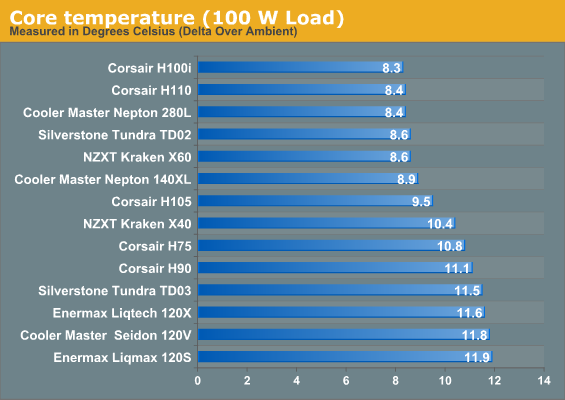
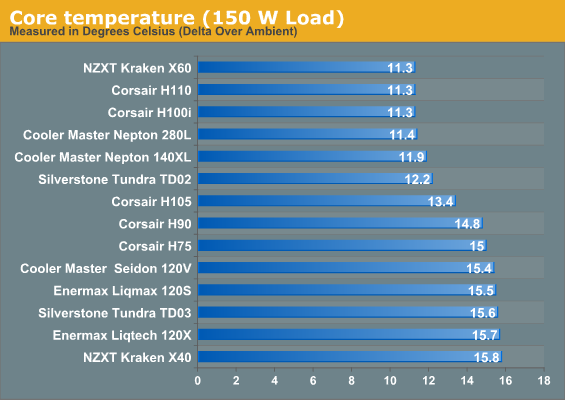
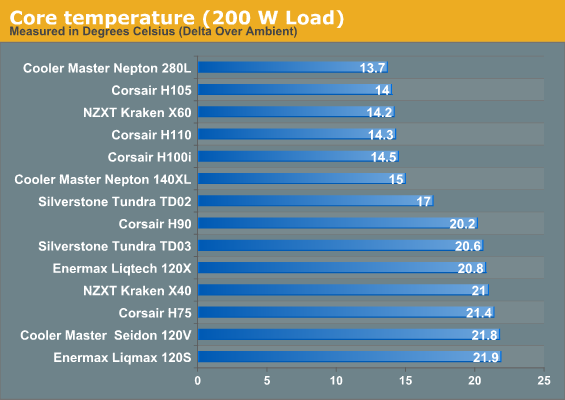

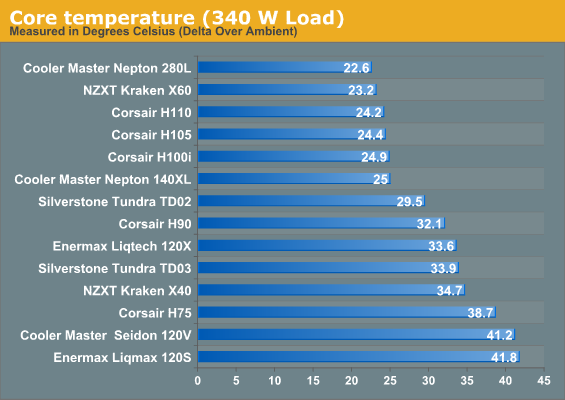

The above charts depict exactly why a user needs to be more than just a little careful when selecting a cooler. Even though they appear similar and some of them even nearly identical, the performance of each and every AIO cooler that we have tested varies greatly. For instance, Cooler Master obviously sought to provide the best heavy-load performance possible and they did manage to reach the top of our charts; however, the noise of the fans that Cooler Master supplied at maximum speed is intolerable for daily use by any standards.
To give you a rough estimate, 56 dB(A) represents about the same level of sound as a typical box fan the same distance. The Nepton 280L is closely followed by the NZXT Kraken X60 and then the Corsair H110, both of which share about the same size and design but not nearly the same noise levels. The NZXT Kraken X60 is over 5 dB(A) quieter than the Nepton 280L, a very perceptible difference, while the Corsair H110 generates only 41.3 dB(A), which is equivalent to a soft humming noise and fairly comfortable for daily use.
Naturally, the performance decreases as we move to AIO coolers with smaller radiators, with the Corsair H100i leading the coolers using 120mm fans but its stock fans run at 2600 RPM, generating high noise levels. The Enermax Liqtech 120X and Silverstone Tundra TD03 and their beefy radiators deliver great thermal performance when compared to other single-fan AIO coolers, although Enermax proved that they could offer roughly the same performance with just one fan and much lower noise levels, making Silverstone's choice to include two fans appear somewhat redundant.
Under a low thermal load however, the charts shift greatly. As the thermal load is much lower, the low temperature dissipation efficiency of the cooler now matters a lot more than its maximum thermal load capacity. Corsair's H100i offers the best thermal performance, outperforming coolers with significantly larger radiators, including Corsair's own H110, closely followed by another 240mm long cooler, the Silverstone Tundra TD02. The gap between the budget-level and high-performance products now closes, with the Corsair H75 being the most notable example, as it manages to outperform its own larger version, the H105. Apparently, bigger is not always better and the lower flow resistance of the single fan radiator gives the Corsair H75 a faster energy transfer rate at lower temperature deltas.










139 Comments
View All Comments
zodiacfml - Thursday, February 13, 2014 - link
Nice job. I like the various loads given to the coolers. Unfortunately, my interest in liquid coolers becomes less as Intel has been lowering the TDP of their CPUs.prateekprakash - Thursday, February 13, 2014 - link
I only wished they'd included Swiftech's H220 and H320 (Even though they aren't available in the US, but I've have been using H220 in my system here in India)buffhr - Thursday, February 13, 2014 - link
Why wasnt the swiftech H220 included in this list? Would of been really nice to see it stack up against 340W and well it is an AIO and meets up with the same price range as well.Rob94hawk - Sunday, February 16, 2014 - link
Because the H220 is a piece of crap due to mass pump failure. I'm on my 3rd one within warranty and I haven't even put it on yet. I have the stock cooler on my 4770k. That's how much confidence I have in the Swiftech H220.Suuave - Thursday, February 13, 2014 - link
A very interesting article but I have a suggestion of one thing would have definitely made it better - a chart. Give us a simple visual reference of "potential cooling performance" vs "noise level" vs "unit size" vs "price" that would give everyone a quick reference of the overall values for the features they are looking for in a sealed system.vgray35@hotmail.com - Thursday, February 13, 2014 - link
What we sorely need is a table of computer cases with a list of water coolers that fit into each case. A valuable reference that does not exist anywhere as far as I know. The reviewers are in the best position with their knowledge to provide such a table.Hrel - Thursday, February 13, 2014 - link
Would have been great if you guys could have included 1-3 air coolers in this review. For comparison.If you don't overclock and primarily care about noise liquid coolers make no sense at all. My air cooler never exceeds 16db. Apparently 36db is the lowest any of these go. That's simply TERRIBLE.
The PC Apologist - Thursday, February 13, 2014 - link
Would have been great if you read through the comments section...Just saying.
Daeros - Thursday, February 13, 2014 - link
This is really bothering me; this article strongly implies that sound pressure equates linearly to to loudness. The decibel scale is logarithmic, true, but while 3db is roughly a doubling in sound energy, it is the smallest difference reliably discernible as louder by people. It takes roughly a 10db increase in sound pressure to have a doubling in perceived loudness. In the example, the 30db difference would be perceived as (roughly) 8 times louder (3 doublings), not 1000 times louder (even though it may be 1000x as much energy).cactusdog - Friday, February 14, 2014 - link
I don't understand why cooler reviews are done with different speed fans, it makes no sense for comparison.